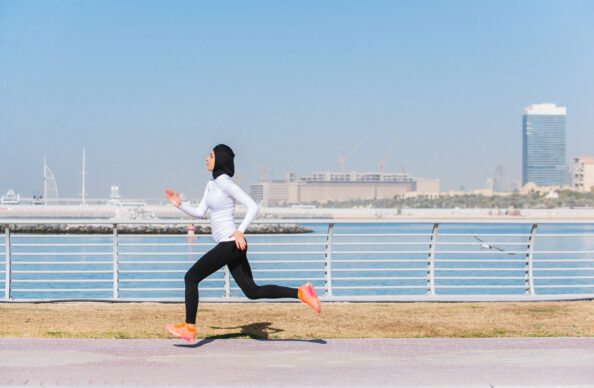by Kathleen O’Neill, DPT >> Request an Appointment
Runners are often guilty of one major thing: only running! They tend to neglect the strengthening necessary to remain healthy and injury free. Four of the key components of a comprehensive runner’s prehab program are strong glutes, a strong core, single leg stability and graded plyometrics to decrease bone stress injury risk. This program touches on each of those four components and is an easy and quick way to keep your cross country and track programs honed. The entire program can be completed in less than 30 minutes and should be incorporated 2-3 times/week, depending on weekly training volume and upcoming races.
GLUTE ACTIVATION
A strong gluteus medius and maximus are integral to an efficient running stride. The glute med helps keep your hips level when your foot hits the ground, which absorbs shock and decreases the load on the knee. A strong glute max allows for stronger hip drive and trunk posture when running.
Side Lying Hip Abduction (start w/ 2 sets x 15 reps each side, work up to 3 sets x 12-15 reps each side)
Lie on your side with hips stacked on top of each other and resistance loop above knees. Keeping hips level, lift the top leg up and slightly back. Keep your core tight and make sure your trunk isn’t rotating.
Standing Hydrant (start w/ 2 sets x 15 reps each side, work up to 3 sets x 12-15 reps each side)
Start in a mini squat position with band around knees. Stand and stabilize on one leg as you externally rotate other leg up and out. You should feel this in both glutes.
Bridges w/ Kick-Out (start w/ 2 sets x 15 reps each side, work up to 3 sets x 12-15 reps each side)
Lying on your back with your knees bent and abs pulled in, push through your heels to lift your hips off the ground. Press firmly through one heel and keep your hips level as you kick the other leg out straight, then switch legs. Keep glutes and core engaged to prevent your hips from dropping as you kick out.
CORE ACTIVATION
A strong core is essential for optimal running posture and to maintain efficient mechanics as you fatigue. The anterior core controls front to back movements, preventing you from arching your back and over-striding. The lateral core helps to keep your trunk upright, hips level, and knee aligned when your foot strikes the ground. The transverse core controls rotational movements, preventing excess rotation at your trunk, hips and knees when running.
Dying Bugs w/ Band (start w/ 2 sets x 15 reps each side, work up to 3 sets x 12 reps each side)
Lay on your back with abs pulled in and back flat with arms extended towards the ceiling and resistance loop around feet. Elevate your legs into table top position, extend one leg out straight, pushing against resistance band and hovering it over the ground. Return to start position and repeat on other side.
Side Plank w/ Leg Swing (start w/ 2 sets x 30 sec each side, increasing time as it gets easier)
Lie on your side with your legs straight, hips stacked on top of each other and your elbow underneath your shoulder. Keeping your abs pulled in and your trunk straight, lift your hips up off the floor. Once you’re stable here, lift the top leg up and swing in front of you and behind you in a marching motion.
Plank Thread the Needle (start w/ 3 sets x 5 reps each side, work up to 3 sets of 10 reps each side)
Start in plank position, with your hands directly under your shoulders and your feet slightly wider than hip width apart. Keeping one hand planted and hips level, lift your other arm up and rotate your chest towards the ceiling. Then reach the same arm underneath your trunk, behind the hand that’s planted.
SINGLE LEG STABILITY
Your single leg stability is challenged every time your foot strikes the ground when running. Strengthening your glutes and core with the previous exercises is essential to establishing a strong foundation, but we also need to challenge those muscles to work with more running-specific demands.
Squat Clock (start w/ 2 sets x 5 reps each side, work up to 3 sets x 10 reps each side)
The squat clock is a runner-specific exercise to challenge stability from your foot up to your hip. Standing on one leg, perform a mini single leg squat while tapping the opposite foot to the ground at 12, 3, 6 and 9 o’clock. Incorporate arm swing to mimic natural running mechanics. Make sure your knee doesn’t collapse inwards and your pelvis stays level. Each cycle around the clock = 1 repetition.
Single Leg RDL (start w/ 2 sets x 10 reps each side, work up to 3 sets x 12 reps each side)
Hinging at your hips, lower your torso forward while raising your back leg. Be sure to keep your back straight, the knee of the supporting leg slightly bent and the hip and knee of the lifted leg straight. Once a stretch is felt or hands contact the floor, return to standing.
PLYOMETRICS
The following plyometric exercises help strengthen tendons, promote bone loading and decrease injury risk including bone stress injury. Programming these into your routine 3 times a week will decrease risk of stress fractures and achilles and patellar tendon irritation.
Pogo Hops (3 sets x 30 sec)
Keeping feet together and knees straight, bounce up and down pushing off through your foot.
Zig Zag Hops (3 sets x 15 hops each side)
Keeping feet together, push off through feet to jump forward in a zig zag pattern. Try to land softly by absorbing shock with each landing.
Try these out and let us know what you think in the comments section!




